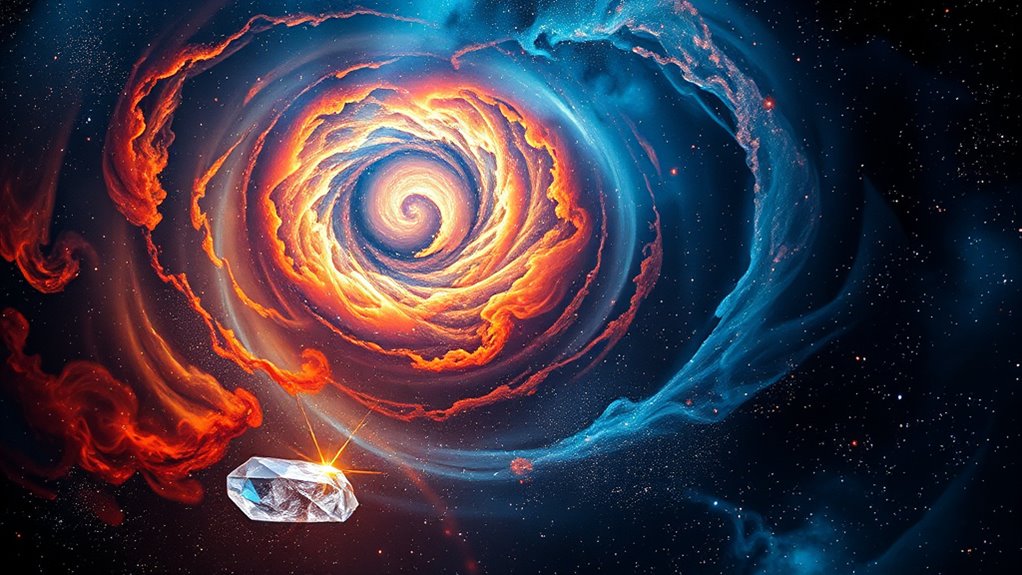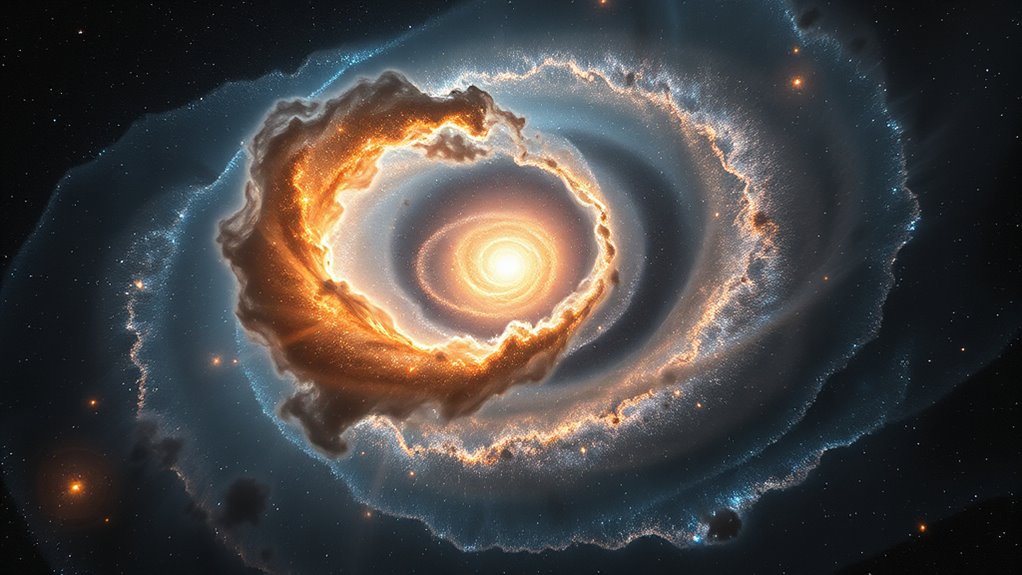Entropy explains why disorder naturally increases in the universe. It measures the number of microstates, or arrangements, that a system can have, with more microstates meaning higher disorder. As energy disperses and systems evolve, disorder grows, making energy less useful for work. This drive toward chaos shapes cosmic evolution, from the formation of galaxies to everyday processes. To understand how disorder drives the universe’s change, explore the key principles behind entropy and energy flow.
Key Takeaways
- Entropy measures the disorder or randomness in a system, and higher entropy indicates greater microstates and chaos.
- The universe naturally evolves toward higher entropy, spreading energy and increasing disorder over time.
- Increased entropy reduces the energy available for organized work, driving processes like cosmic expansion and thermodynamic change.
- The second law of thermodynamics states that total entropy tends to increase, shaping the universe’s direction and evolution.
- Disorder and energy dispersal underpin cosmic phenomena, from galaxy formation to the universe’s eventual heat death.
What Is Entropy and How Is It Measured?

Entropy is a measure of disorder, randomness, or uncertainty within a system. You can think of it as how spread out or dispersed energy becomes among particles. It also reflects the number of microscopic arrangements, or microstates, that match a system’s observable state. Understanding the importance of color accuracy in visual representations helps to appreciate its role in representing entropy-related concepts accurately in scientific imaging. To quantify entropy, scientists use the formula (S = -k_B sum p_i ln p_i), where (p_i) is the probability of each microstate, linking microscopic behavior to macroscopic properties. You measure changes in entropy by calculating the heat transferred reversibly divided by temperature, (Delta S = Q_{rev}/T). Units of entropy are joules per kelvin (J·K⁻¹). Absolute entropy is determined through thermodynamic principles, like the third law, which states perfect crystals at 0 K have zero entropy. Additionally, entropy tends to increase in natural processes, reflecting the second law of thermodynamics, which governs the direction of spontaneous changes. Recognizing how microstates influence entropy helps in understanding the microscopic basis of thermodynamic behavior.
The Role of Entropy in Thermodynamics

In thermodynamics, understanding how entropy relates to energy dispersal and system disorder helps clarify how energy transformations occur. You see, entropy measures how energy spreads out and how ordered a system is. It’s a state function, meaning it depends only on the current state, not how the system got there. Energy dispersal is a key concept connected to entropy, illustrating how energy naturally tends to spread out over time. When heat transfers reversibly, the change in entropy can be calculated without considering the path taken. The second law states that total entropy always increases or stays the same, guiding the direction of heat flow from hot to cold. This increase in entropy explains why processes like friction or diffusion are irreversible. Fundamentally, entropy sets common limits on energy efficiency and helps describe the natural tendency toward disorder in all energy transformations. Additionally, the concept of entropy is essential in understanding system equilibrium and the direction of spontaneous processes. Recognizing how entropy influences energy efficiency provides insight into why some processes are naturally favored over others.
Entropy From a Statistical Mechanics Perspective

From a statistical mechanics perspective, entropy measures how many microscopic configurations—or microstates—correspond to a given macroscopic state, such as a specific temperature or pressure. It reflects the uncertainty or disorder within the system, considering all the possible arrangements of particles consistent with the observed macrostate. It is also influenced by the number of accessible microstates, which directly relates to how energy is distributed among particles in the system. A higher number of microstates means greater disorder and higher entropy. Additionally, understanding entropy measurement techniques can help contextualize the practical application of entropy in various fields. This statistical view explains thermodynamic entropy at a microscopic level, showing how energy disperses among particles. When microstates increase, the system becomes more disordered, and entropy rises. This perspective connects microscopic particle behavior directly to the macroscopic properties we observe.
Quantum Entropy and Its Implications

Have you ever wondered how uncertainty manifests in quantum systems? Quantum entropy measures this uncertainty, reflecting the disorder or unpredictability in a system’s state. It involves various types, like von Neumann entropy and entanglement entropy, which help quantify quantum correlations and information flow. Understanding how air pollution from sources like wood-burning impacts environmental and human health can further deepen our appreciation of how disorder influences complex systems.
To calculate it, you start with the density matrix, diagonalize it, and then sum the eigenvalues weighted by their logarithms. These eigenvalues represent the probabilities of different states.
Quantum entropy plays a crucial role in quantum information processing, cryptography, and error correction, setting fundamental limits on how much information can be stored or transmitted. It also offers insights into entangled systems, revealing how parts of a larger quantum system share and transfer information.
Entropy and the Evolution of the Universe

The total entropy of the universe steadily increases over cosmic time, reflecting the growing disorder as the universe evolves. Early on, radiation dominated entropy due to its vast phase space, but as the universe expands, matter’s entropy density decreases more slowly, making it the main contributor later.
This shift results from matter’s ability to cluster and form structures, which increases its entropy through gravitational clumping. Meanwhile, dark energy remains consistent with a low, unchanging entropy density, playing a different thermodynamic role.
The overall rise in entropy aligns with the Second Law of Thermodynamics, showing a continual progression toward disorder. As the universe expands, the increasing entropy illustrates the ongoing evolution from initial uniformity toward complex, structured systems.
The Concept of the Arrow of Time

The arrow of time describes the unidirectional flow of time from the past to the future, and it’s closely connected to the concept of entropy. You can see this in how processes like gas expansion or aging always move forward, never backward.
Entropy, which measures disorder, tends to increase in spontaneous events, guiding this direction. According to the second law of thermodynamics, total entropy in an isolated system always rises, making certain processes irreversible.
Entropy increases spontaneously, ensuring processes are irreversible and defining the arrow of time.
While microscopic interactions can sometimes be reversed, macroscopic systems show a clear time direction because of increasing entropy. As energy disperses over time, systems reach equilibrium, where entropy is maximized.
This increase in disorder underpins why time flows forward and why certain events never spontaneously reverse.
Entropy in Society and Social Structures

Entropy isn’t limited to physical systems; it also shapes social structures and societal stability. Social entropy measures disorder or randomness within societies, influenced by factors like economic inequality and corruption.
High social entropy indicates disorganization, weakened social cohesion, and fragmented cultural norms, while low entropy reflects unity, shared values, and stability. Societies with elevated entropy often experience social unrest, disruptions, and challenges to institutions.
External influences, such as popular culture or unpredictable events, can temporarily lower entropy by fostering shared interests or unity. Conversely, economic disparities create divisions that increase social entropy and hinder social mobility.
Addressing these issues through policies aimed at reducing inequality and corruption can help restore order and strengthen social cohesion.
Practical Uses of Entropy in Industry and Environment

Applying entropy principles plays a vital role in various industrial and environmental practices, helping optimize processes and improve sustainability. In industry, you can enhance thermal efficiency in engines and reactors by managing waste heat, extending equipment lifespan. Waste-to-energy plants convert waste into biogas, reducing landfill use and generating renewable power.
Entropy analysis also improves manufacturing energy conversions and material synthesis, making processes more sustainable and reliable. Environmentally, entropy helps monitor ecosystem health and climate dynamics, aiding in biodiversity conservation and climate impact assessments. Waste management techniques like anaerobic digestion rely on entropy principles to process waste efficiently.
Additionally, in renewable energy, entropy maximization enhances solar cell performance, supporting cleaner energy solutions. These applications demonstrate how understanding entropy drives efficiency and sustainability across sectors.
The Relationship Between Disorder and Energy Availability

Understanding how disorder relates to energy availability reveals that as systems become more disorganized, less energy remains useful for doing work. When entropy increases, energy disperses across more states, making it less concentrated and harder to harness.
For example, heat transfer from hot to cold spreads energy, reducing its usefulness. As molecular arrangements become more random, the potential for organized work diminishes. In expanding systems like gases, energy occupies more levels, increasing disorder.
When mixing fluids or dissolving substances, energy disperses further, lowering its availability. Overall, higher disorder reflects a decrease in accessible energy, meaning systems naturally evolve toward states where less energy can perform useful work.
This relationship underpins why energy becomes less available as entropy rises, shaping the universe’s ongoing transformation.
Future Perspectives on Entropy and Universal Change

The evolving understanding of entropy highlights its role not only in shaping the past but also in guiding the future of the universe. You see, the universe is increasing its global entropy while simultaneously creating local order and complexity. This dual process involves accelerating entropy production alongside rapid development of structures through evolution.
As entropy rises, the universe’s energy potential diminishes, steering cosmic evolution toward eventual equilibrium or heat death. Fascinatingly, local order emerges in adaptive systems, balancing global disorder. These opposing trends suggest a universe dynamically managing disorder and complexity, both speeding up over time.
Frequently Asked Questions
How Does Entropy Relate to Information Theory and Data Compression?
You might wonder how entropy relates to information theory and data compression. It quantifies the uncertainty or unpredictability in data, helping you determine the best way to encode messages efficiently.
Higher entropy means more randomness, making compression harder. By understanding entropy, you can develop algorithms like Huffman coding that minimize the number of bits needed, optimizing data storage and transmission while preserving information.
Can Entropy Decrease in Any Physical or Social Systems?
You wonder if entropy can decrease in physical or social systems. It can, but only with external energy input or resources.
In physical systems, processes like freezing or refrigeration lower internal entropy, but they increase the surroundings’ entropy.
In social systems, organization improves with effort, resources, and energy, reducing local disorder. However, overall, the total entropy of the universe still increases, following the second law of thermodynamics.
What Role Does Entropy Play in Quantum Computing Advancements?
You see, entropy plays a vital role in quantum computing advancements by transforming how we view disorder. Instead of seeing entropy as a problem, researchers now harness it as a resource, enabling more scalable and efficient systems like Entropy Quantum Computing.
Managing quantum entropy helps optimize qubit stability and reduces decoherence, allowing you to push the boundaries of quantum technology and develop powerful, reliable quantum computers.
How Is Entropy Linked to the Concept of Free Energy?
Did you know that over 90% of the universe’s energy is stored as entropy?
When you ask how entropy relates to free energy, think of it this way: entropy measures disorder, and free energy indicates a system’s capacity to do work.
Higher entropy increases free energy’s role in spontaneous reactions, especially at higher temperatures, showing that disorder directly influences a system’s energy available for work and change.
Are There Practical Methods to Control or Reverse Entropy in Real Systems?
You might wonder if you can control or reverse entropy in real systems. While you can’t fully reverse it due to the second law of thermodynamics, you can manage it.
By controlling energy and material flows, minimizing irreversible processes, and exporting entropy to the environment, you can slow its increase locally.
Techniques like quantum control and statistical monitoring help, but global reversal remains practically impossible.
Conclusion
As you explore entropy, imagine the universe’s endless dance of sparks fading into twilight, where disorder gently spreads like dawn’s first light. It’s this relentless march toward chaos that fuels change, shaping everything from stars to society. Embrace the idea that disorder isn’t just chaos but a essential force driving evolution and energy flow. Understanding this cosmic rhythm helps you see the beauty in transformation, guiding you through the universe’s perpetual journey toward greater entropy.









